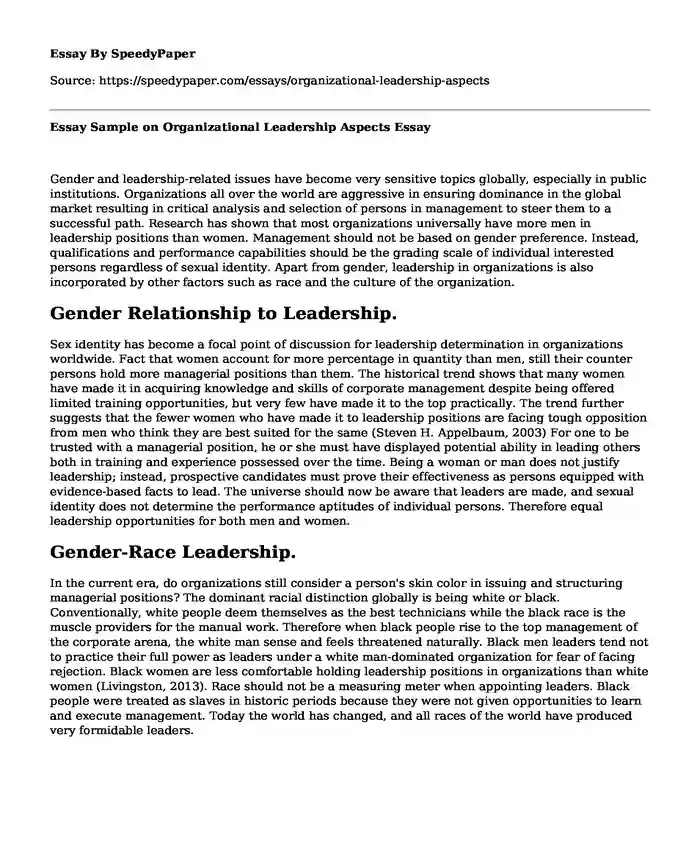
| Type of paper: | Critical thinking |
| Categories: | Race Women Gender Discrimination Leadership development |
| Pages: | 3 |
| Wordcount: | 719 words |
Gender and leadership-related issues have become very sensitive topics globally, especially in public institutions. Organizations all over the world are aggressive in ensuring dominance in the global market resulting in critical analysis and selection of persons in management to steer them to a successful path. Research has shown that most organizations universally have more men in leadership positions than women. Management should not be based on gender preference. Instead, qualifications and performance capabilities should be the grading scale of individual interested persons regardless of sexual identity. Apart from gender, leadership in organizations is also incorporated by other factors such as race and the culture of the organization.
Gender Relationship to Leadership.
Sex identity has become a focal point of discussion for leadership determination in organizations worldwide. Fact that women account for more percentage in quantity than men, still their counter persons hold more managerial positions than them. The historical trend shows that many women have made it in acquiring knowledge and skills of corporate management despite being offered limited training opportunities, but very few have made it to the top practically. The trend further suggests that the fewer women who have made it to leadership positions are facing tough opposition from men who think they are best suited for the same (Steven H. Appelbaum, 2003) For one to be trusted with a managerial position, he or she must have displayed potential ability in leading others both in training and experience possessed over the time. Being a woman or man does not justify leadership; instead, prospective candidates must prove their effectiveness as persons equipped with evidence-based facts to lead. The universe should now be aware that leaders are made, and sexual identity does not determine the performance aptitudes of individual persons. Therefore equal leadership opportunities for both men and women.
Gender-Race Leadership.
In the current era, do organizations still consider a person's skin color in issuing and structuring managerial positions? The dominant racial distinction globally is being white or black. Conventionally, white people deem themselves as the best technicians while the black race is the muscle providers for the manual work. Therefore when black people rise to the top management of the corporate arena, the white man sense and feels threatened naturally. Black men leaders tend not to practice their full power as leaders under a white man-dominated organization for fear of facing rejection. Black women are less comfortable holding leadership positions in organizations than white women (Livingston, 2013). Race should not be a measuring meter when appointing leaders. Black people were treated as slaves in historic periods because they were not given opportunities to learn and execute management. Today the world has changed, and all races of the world have produced very formidable leaders.
Organizational Culture and Leadership.
Organizations' norms of operation in the ever-changing world business arena have a great influence in setting up its managerial personnel structure. The culture of the organization builds up the relationship among employees, and for one to lead others, they should share this mutual relationship for easy acceptance and coordination. Leadership has been traditionally associated with the ability to influence and inform the beliefs and activities of both internal and external publics of the organization, hence qualifying leadership as culture itself (Werhane, 2011). The world is changing, and flexibility has been a mode of survival to many organizations. Business enterprises prefer their long-serving employees to positions of management because they are well-versed in the culture of the organization. This is not an idea with the ever-changing trends in the world. Organizations should not stick to their traditional cultures for long since they can be trapped in them, making it impossible to adjust to the modern world organization setting.
From gender, race, and organizational culture, there are no feasible nature-related parameters that justify leadership in a person. Managers are trained and nurtured into a task rather than being handpicked due to preconceived perceptions. Neutrality in leadership is essential for an organization's successful business venture; therefore, equal opportunities to all interested qualified personnel is vital and good for operations.
References
Livingston, R. W. (2013). Gender, Race, and Leadership. Gender and Work, 1-6.
Steven H. Appelbaum, L. A. (2003). Gender and Leadership? Leadership and Gender? Development Journal., 43-51.
Werhane, P. H. (2011). Leadership, Gender, and Organizations. Issues in Business Ethics, 140-169.
Jackie, F. (2006). The discourse of Leadership: Gender Identity. Leadership 77-91.
Cite this page
Essay Sample on Organizational Leadership Aspects. (2023, Jan 19). Retrieved from https://speedypaper.com/essays/organizational-leadership-aspects
Request Removal
If you are the original author of this essay and no longer wish to have it published on the SpeedyPaper website, please click below to request its removal:
- Free Essay on Medical Savings Accounts
- Essay Sample on Supply of Fresh Fruit from Australia to South Korea
- Definition Essay Example: Community
- Essay Example on the Implementation of Electronic Health Records
- Paper Example. Practical Ideas for Reform on Violence Against Children
- Understanding Historical Views on Slavery and Mental Health - Free Paper Sample
- Become a Clergy - Free Paper Example
Popular categories




